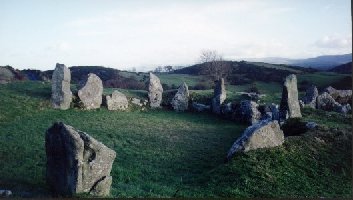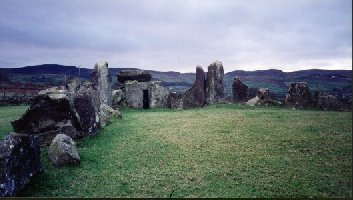Welcome to Killeavy.com

All the Cairns in the Killeavy area, are of the Neolithic Age (4000 BC – 2000 BC). The oldest Cairns are the highest; these are the two Passage Cairns on top of Slieve Gullion, approx. height 1,890 ft.
Next in this period are the Court Cairns - Ballymacdermott and Clonlum - and these were followed closely by the Horned Cairns, an example of which is Clontigora and lowest of all we have the Round Cairns, an example of which is at Clonlum. The Cairns are constructed of the same rock type as that of their surrounding relief.
The two Slieve Gullion Cairns are “Cruciform Passage Graves”. They resulted from the fusion of three Influential styles of Megalithic Tomb Architecture. They are Clare Dolmans, Tholos and Gallery Graves. These Cairns are at the beginning of the series, and all other Cairns fundamentally stem from these. Excepting Ballymacdermott, which is a Court Cairn, it is similar to Clonlum Court Cairn. A characteristic is it's “horns”, which were possibly influenced by West Ulster and Connaught, where it is a common feature. The large Cairn at Clontigora is a “Horned Cairn”. It is of the category “Gallery Grave”, basically used for ceremonial rites, in which fires played a great part. The 'Horns' are a late development possibly as a result of influence from Sardinia - Potsherds have been found to prove this.
The other two small Cairns
in Clontigora appear to be similar to the
“Round Cairns” in Clonlum.
Clontygora Cairn

About 2,500 B. C. new men with new ideas came to Ireland. These men were Neolithic or New Stone Age men. They were in fact Ireland's first farmers, and tilled the soil and grew their own crops. When one of these men died, then they were always buried in the family vault or tomb known as a "megalith" – which means "made of large stones".
The two main types of grave these men built were the "court cairn" like this one or Ballymacdermot Court Cairn and the Passage grave; like New Grange in Boyne Valley.
Clontigora cairn, one of the best examples of the 200 known Irish cairns has withstood the ravages of time, and has been excavated no later than 1937, when small pieces of bones and fossils were unearthed. Records claim that at least one cremation had taken place at this very cairn. Three chambers built from massive slabs and the central burial gallery was originally covered, stones forming a cavin.
Remarkably enough, all traces of this cavin or stone mound have been removed and apparently were used in the building of Newry Canal.
The number of cairns in our area, is particularly high.This is because it is relatively near the sea, therefore, convenient for those coming from Europe. The cairns show evidence of people settling from Portugal and Sardinia, e.g. potsherds found in Clontigora Cairn are of the same type found in Portugal. Also all the cairns are situated above 300 feet. This was because the, water level at that time was much higher and dense forests and swamps were oven found on mountainsides, thus making habitation impossible.















